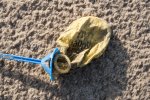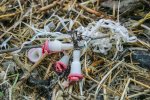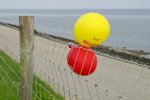Generic article
Trends in balloon litter on beaches in the Netherlands
In recent years a significant reduction in the quantity of litter from balloons found on Dutch beaches can be documented. Such data represent a welcome support to all those that make efforts to reduce such waste. However, it is also evident that the job is not done, because the beaches are not nearly clean yet!
King's Day (27 Apr) and Liberation Day (5 May) are an appropriate point in time to evaluate the situation of balloons littering the Dutch beaches. Over the last years, many individuals and organisations have invested substantial effort in reducing balloon releases because of the negative impacts on nature and the environment. In 2014 the Dutch Parliament agreed to request the government to discourage balloon releases nationwide.
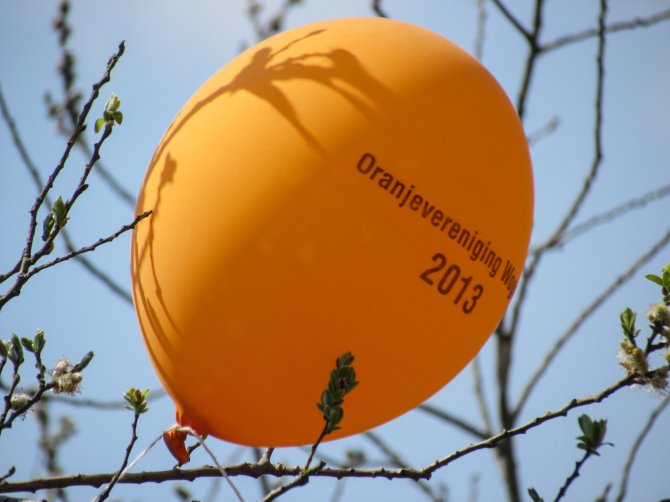
In a national inquiry by ‘Die Ballon Gaat Niet Op’ among local royal associations, 69 of 305 have now indicated to have banned or intend to ban their traditional releases of large number of orange balloons during Kings Day (www.dieballongaatnietop.nl, a cooperation of North Sea Foundation, Plastic Soup Foundation and the Coastal & Marine Union). Other types of releases are often discussed in the media, sometimes resulting in releases being cancelled. Have all these efforts resulted in a noticeable change on our beaches?
Counting balloon litter
Each year, the North Sea Foundation (SDN), commissioned by Rijkswaterstaat (RWS) of the Netherlands Ministry of Infrastructure and Environment, conducts surveys of marine litter on Dutch beaches. On four different beaches (Terschelling, Bergen, Noordwijk, Veere), four times each year, a dedicated survey is conducted over fixed 100m beach sections using internationally agreed methodology for monitoring beach litter. In 2013, Wageningen Marine Research, was asked by RWS to evaluate the beach litter data over the period 2004-2012. That analysis provided evidence that over the 2004-2012 period a strongly significant (p<0.001) increase had occurred in the number of balloons on the beaches (the p-value reflects reliability of statistical calculations: if p is smaller than 0.05, the risk of a wrong conclusion is calculated at being less than 5% and the result considered reliable or significant; however, where p exceeds 0.05 the risk for a wrong conclusion increases and the result is then considered as being unreliable, or insignificant).
New data are now available, adding four years of additional surveys up to inclusive 2016. This allows a new analysis to evaluate whether all efforts by individuals and organisation aiming at a reduction in balloon releases have been effective. Over the full 2004-2016 period, a general analysis of the annual data did not directly indicate much change (https://www.noordzee.nl/die-ballon-gaat-niet-op/). The long-term average of balloon debris is about 12 to 13 balloons per 100m beach. Have efforts to make a change been wasted?
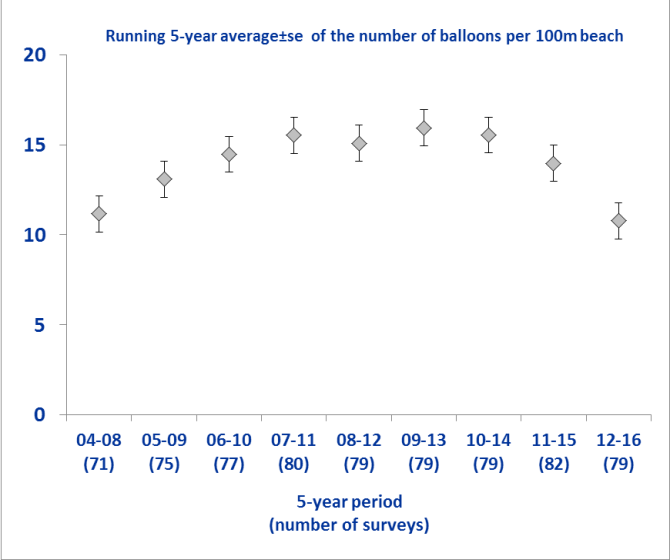
Analysis
A more detailed analysis using the methods outlined in the 2013 report, confirms that beaches free of balloon debris are still non-existent. However, the analysis does indicate a change in the trend. Individual surveys show huge variability because e.g. wind and blowing sand can cause rapid short-term differences in the amount of material in the tidelines and their detectability. As a consequence, seasonal averages (4 counts per season) and even annual averages (in general based on16 counts) can show rather chaotic patterns in balloon density. By viewing data grouped in so-called 5-year running averages (each based on c. 80 100m surveys), a better impression can be obtained of potential long term changes. Such analysis shows that we cannot consider the long-term time series to reflect a linear trend. Rather the five-year running averages indicate that the earlier documented increase has changed to a decrease in more recent years. From an initial figure of 11 balloons per 100m beach the five-year average increased to almost 16 around 2010, but decreased to 10.8 over the period 2012-16.
Graphs using running averages provide a nice impression of potential trends, but are of no value in statistical terms. The 2013 report had shown that proper statistical analysis should evaluate all individual surveys in relation to the year the data were collected. In addition, correct analysis requires so-called normalisation of the data, which implies usage of log transformed numbers which reduces the influence of extreme outliers.
Viewing the individual surveys over the full 2004-2016 period indeed shows no statistical trend (198 surveys, p=0.657 not significant). However, the five-year running averages indicate that data should be split into separate time periods. The year to make the split is an arbitrary choice. In the graph shown here, a choice was made to analyse data from the past six years (2001-2016) in comparison to the earlier period. The six-year period is the standard that was internationally agreed for analyses evaluating trends in beach litter data.
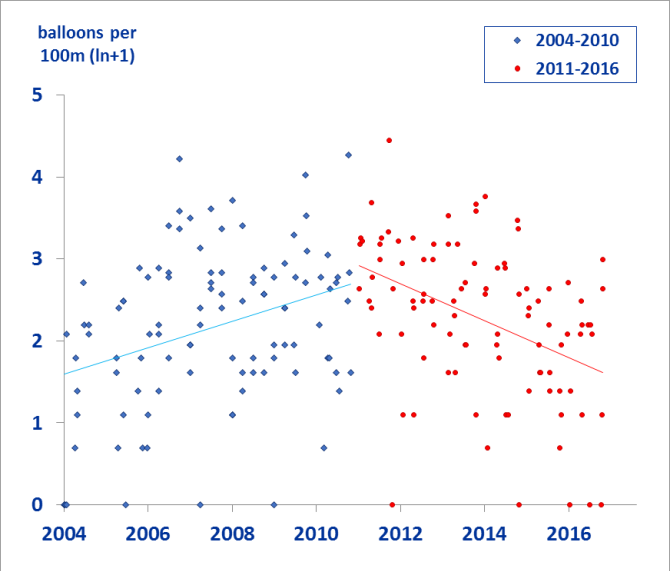
Significant downward trend in balloon litter
The analysis of the surveys 2011-2016 reveals a strongly significant downward trend in the number of balloons beached in the Netherlands (red dots and trendline in the graph; based on 98 surveys; trend significant at p<0.001; NB the y-axis of the graphs show log transformed data, as used for the trend analysis). During the earlier 2004-2010 period a contrasting significant increase can be seen (102 surveys, p=0.003; blue diamonds and trendline).
These results are certainly robust, and hold when the arbitrary split between periods is taken differently. Analyses for the short 4-year period 2013-2016 following the 2013 report confirm a recent significant decrease (64 surveys, p=0.002) and earlier increase (132 surveys, p<0.001). If calculated over the standard 10-year period for trend-analyses in the monitoring of plastic ingestion by northern fulmars the 2007-2016 decrease in balloons at our beaches is still significant (159 surveys, p=0.010).
Further confirmation of the trends can be seen by analysing data for separate beaches or seasons. From 2011 to 2016 all four Dutch beaches, in spite of the reduced number of surveys available (24 per beach) show a reduction in balloon litter, in three of them significant (Terschelling p=0.009; Bergen not significant p=0.719; Noordwijk p=0.001; Veere p=0.020). If data are separated by season over years 2011-2016 (21-28 surveys per season) a similar result for decreasing balloon litter is confirmed (Jan-Mar p=0.027; Apr-Jun p=0.027; Jul-Sep p=0.042; Oct-Dec not significant p=0.215).
The recent survey data fort all these analyses were made available by the North Sea Foundation and Rijkswaterstaat. These organizations produce annual reports on Dutch beach litter monitoring, in which analyses are made using the international OSPAR beach litter monitoring software package ‘Litter Analyst’. The report containing data up to 2016 is in preparation and has not yet been published, but draft results confirm that also the Litter Analyst calculations show a significant decrease (p<0.001) over the 2011-2016 period, with a median value 10.8 balloons per 100m beach.
Litter from balloons still requires our attention
In conclusion, a first general view of all survey data over the full time period since 2004 did not give a clear picture. However, when looking in more detail, the initial trend of increase in balloon numbers has reversed into a trend of significant decrease in recent years on Dutch beaches. However, the number of balloons, now about 10 to 11 per 100m, remains very substantial and requires continued efforts towards reduction. Such efforts are also needed in neighbouring countries. Balloons released in the UK easily cross the North Sea to find the end of their live on Dutch beaches (see article The Times). But the turning point towards noticeable improvement has passed and should stimulate further efforts.
See also:
- Van Franeker, J.A. 2013. Survey of methods and data analyses in the Netherlands OSPAR Beach Litter Monitoring program. Report June 2013, IMARES Texel, 35pp. OSPAR-ICGML (11) 13/4/5-E. http://www.kenniswijzerzwerfafval.nl/download_document/346
- Ouwehand, E. 2014. Motie van het lid Ouwehand (Oplaten ballonnen). Tweede Kamer, vergaderjaar 2014-2015, 30 872, nr. 177. https://zoek.officielebekendmakingen.nl/kst-30872-177.html
- M. Hougee & M. Boonstra, 2016. OSPAR Beach Litter Monitoring In the Netherlands 2010- 2015. Annual Report. North Sea Foundation, Utrecht. https://www.noordzee.nl/project/userfiles//BM_16.05_Annual_report_2010_2015_OSPAR_Beach_Litter_Monitoring_In_the_Netherlands.pdf
- M. Boonstra & M. Hougee 2017 (in prep). OSPAR Beach Litter Monitoring In the Netherlands 2011-2016. Annual Report. North Sea Foundation, Utrecht.
- Litter analyst information: http://www.amo-nl.com/wordpress/software/litter-analyst/
With thanks to Marijke Boonstra (North Sea Foundation) and Willem van Loon (RijksWaterStaat)
Photos of balloons littering the Texel coast


